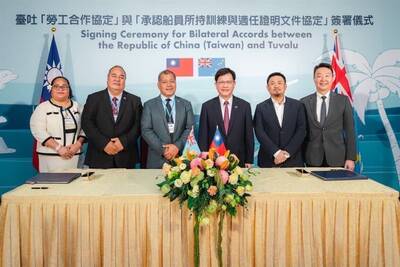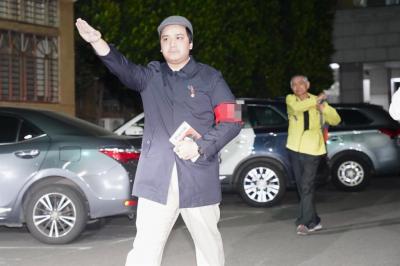The Taipei City Government’s Cultural Heritage Evaluation Committee on Thursday designated a memorial cemetery in Liuzhangli (六張犁) as a municipal cultural landmark, overriding the recommendation of its parent organization, Taipei’s Department of Cultural Affairs.
Built in 2003 by Taipei’s Department of Social Welfare, the Memorial Cemetery for Victims of Political Persecution during the Martial Law Period (戒嚴時期政治受難者墓園) is the final resting place for many people killed during the White Terror era, when the then-Chinese Nationalist Party (KMT) government implemented martial law, purging dissidents and suspected communists.
The graves of at least 200 people killed during the White Terror era are in the memorial cemetery, including that of Huang Jung-tsan (黃榮燦), the artist that carved the famous Horrifying Inspection (恐怖的檢查) depicting the 228 Incident that took place in 1947.
In July, Democratic Progressive Party (DPP) Taipei City councilors Lee Chien-chang (李建昌) and Chien Shu-pei (簡舒培) slammed the city government for neglecting to designate the cemetery as a cultural landmark, in spite of a pledge from the municipal administration to do so 14 years ago.
Warning that the cemetery was at risk from soil erosion, the councilors also criticized the city government over failing to maintain the site or provide guided tours.
Pursuant to Taipei Mayor Ko Wen-je’s (柯文哲) promise to make policymaking processes more transparent, the committee meeting was open to the media and a video record of its proceedings was made available to the general public.
Representatives from the Department of Cultural Affairs resisted the motion, saying that the cemetery lacked cultural value.
Instead, they suggested that a mortuary tower “museum” be built over the site.
Civic group representatives contested the department’s claims, arguing that the cemetery is a unique historical site.
They said that building a mortuary tower would negatively affect the cemetery by altering its features.
Committee member Hsia Chu-chiu (夏鑄九), an urban-planning professor emeritus at National Taiwan University, said the cemetery’s historical value is “beyond doubt” and that technical difficulties should not exclude it being designated a cultural landmark.
Additional Reporting by Yu Pei-ju

The Ministry of Economic Affairs has fined Taobao NT$1.2 million (US$36,912) for advertisements that exceed its approved business scope, requiring the Chinese e-commerce platform to make corrections in the first half of this year or its license may be revoked. Lawmakers have called for stricter enforcement of Chinese e-commerce platforms and measures to prevent China from laundering its goods through Taiwan in response to US President Donald Trump’s heavy tariffs on China. The Legislative Yuan’s Finance Committee met today to discuss policies to prevent China from dumping goods in Taiwan, inviting government agencies to report. Democratic Progressive Party Legislator Kuo Kuo-wen (郭國文) said

The Ministry of Economic Affairs has fined Taobao NT$1.2 million (US$36,900) for advertisements that exceeded its approved business scope and ordered the Chinese e-commerce platform to make corrections in the first half of this year or its license would be revoked. Lawmakers have called for stricter supervision of Chinese e-commerce platforms and more stringent measures to prevent China from laundering its goods through Taiwan as US President Donald Trump’s administration cracks down on origin laundering. The legislature’s Finance Committee yesterday met to discuss policies to prevent China from dumping goods in Taiwan, inviting government agencies to report on the matter. Democratic Progressive Party

Taiwan and its Pacific ally Tuvalu on Tuesday signed two accords aimed at facilitating bilateral cooperation on labor affairs, according to Taiwan’s Ministry of Foreign Affairs (MOFA). The governments inked two agreements in Taipei, witnessed by Foreign Minister Lin Chia-lung (林佳龍) and visiting Deputy Tuvaluan Prime Minister Panapasi Nelesone, MOFA said in a news release. According to MOFA, the agreements will facilitate cooperation on labor issues and allow the two sides to mutually recognize seafarers’ certificates and related training. Taiwan would also continue to collaborate with Tuvalu across various fields to promote economic prosperity as well as the well-being of their

Sung Chien-liang (宋建樑), who led efforts to recall Democratic Progressive Party (DPP) Legislator Lee Kun-cheng (李坤城), was released on bail of NT$80,000 today amid outcry over his decision to wear a Nazi armband to questioning the night before. Sung arrived at the New Taipei District Prosecutors’ Office for questioning in a recall petition forgery case last night wearing a red armband bearing a swastika, carrying a copy of Adolf Hitler’s Mein Kampf and giving a Nazi salute. Sung left the building at 1:15am without the armband and covering the book with his coat. Lee said today that this is a serious